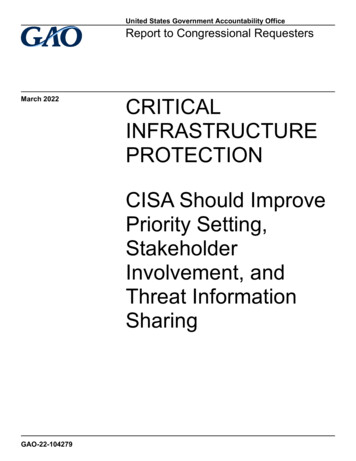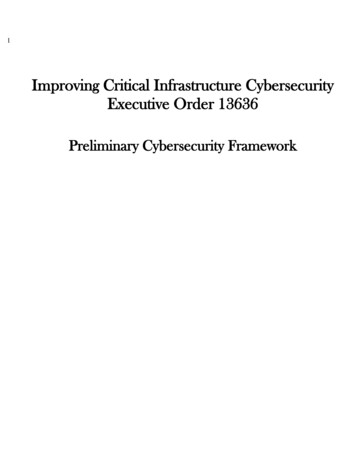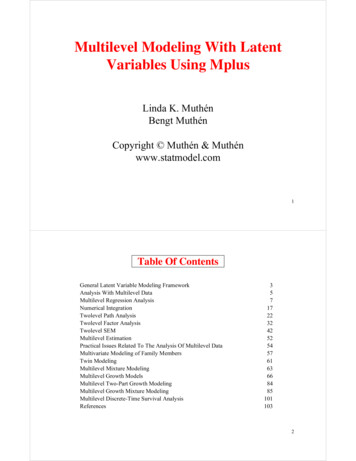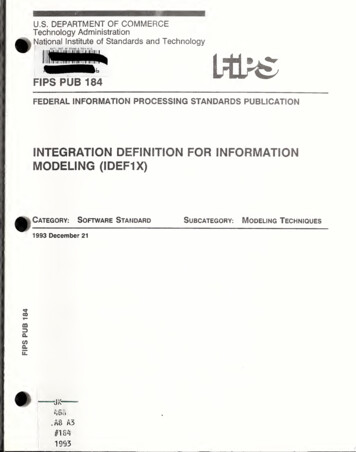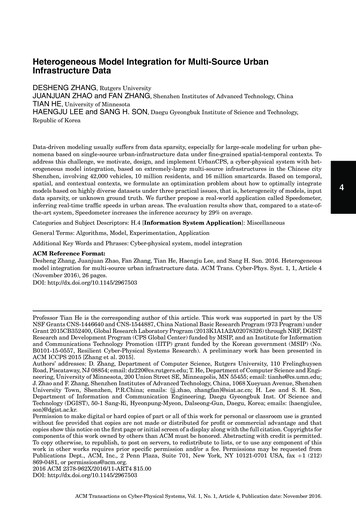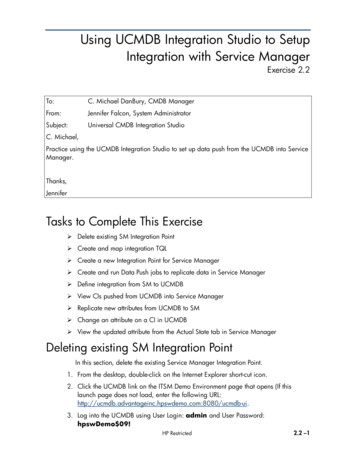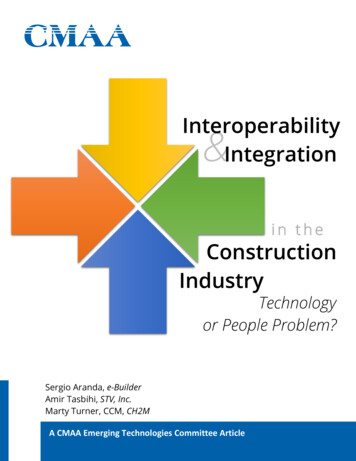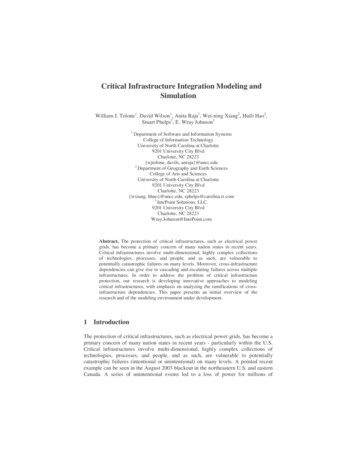
Transcription
Critical Infrastructure Integration Modeling andSimulationWilliam J. Tolone1, David Wilson1, Anita Raja1, Wei-ning Xiang2, Huili Hao2,Stuart Phelps2, E. Wray Johnson31Department of Software and Information SystemsCollege of Information TechnologyUniversity of North Carolina at Charlotte9201 University City BlvdCharlotte, NC 28223{wjtolone, davils, anraja}@uncc.edu2Department of Geography and Earth SciencesCollege of Arts and SciencesUniversity of North Carolina at Charlotte9201 University City BlvdCharlotte, NC 28223{wxiang, hhao}@uncc.edu, sphelps@carolina.rr.com3IntePoint Solutions, LLC.9201 University City BlvdCharlotte, NC 28223Wray.Johnson@IntePoint.comAbstract. The protection of critical infrastructures, such as electrical powergrids, has become a primary concern of many nation states in recent years.Critical infrastructures involve multi-dimensional, highly complex collectionsof technologies, processes, and people, and as such, are vulnerable topotentially catastrophic failures on many levels. Moreover, cross-infrastructuredependencies can give rise to cascading and escalating failures across multipleinfrastructures. In order to address the problem of critical infrastructureprotection, our research is developing innovative approaches to modelingcritical infrastructures, with emphasis on analyzing the ramifications of crossinfrastructure dependencies. This paper presents an initial overview of theresearch and of the modeling environment under development.1 IntroductionThe protection of critical infrastructures, such as electrical power grids, has become aprimary concern of many nation states in recent years - particularly within the U.S.Critical infrastructures involve multi-dimensional, highly complex collections oftechnologies, processes, and people, and as such, are vulnerable to potentiallycatastrophic failures (intentional or unintentional) on many levels. A pointed recentexample can be seen in the August 2003 blackout in the northeastern U.S. and easternCanada. A series of unintentional events led to a loss of power for millions of
businesses and homes. Moreover, failure in the electrical power infrastructure hadserious impacts on other critical infrastructures. For example, the loss of power alsoled to a loss of water in many communities, as water systems depend heavily onpower to operate the pumping systems that deliver water for consumption. The tightcouplings within and across infrastructures and the brittleness that can result wereclearly evident in the length of time it took to restore power to the affected region. Italso was evident that failure isolation is a difficult task within complexinfrastructures, let alone across infrastructures. While the August 2003 blackout maynot be considered catastrophic from a human perspective, it was clearly catastrophicfrom an economic perspective.Given the breadth and depth of critical infrastructures, one can readily observecharacteristics that make the problem of protecting a nation’s critical infrastructures,in general, intractable. Key among these characteristics is the inherent complexity ofthe infrastructures, each defining a unique field of research with numerous openproblems regarding organization, operation, and evolution. For example, electricpower systems are complex, semi-redundant networks of power generation,transmission, and distributions facilities relying upon technologies that may vary inage in excess of twenty years. Rinaldi et. al. [22] refer to such infrastructures ascomplex adaptive systems. Furthermore, many of these critical infrastructures weredesigned and constructed over several decades with few, if any, securityconsiderations in mind. Aside from nuclear power generation facilities, this isparticularly true of the energy sector. As a result, each of these critical infrastructuresfaces a clear and present danger of failure by accident or design.Magnifying these challenges and the dangers that arise are numerous inherentinterdependencies that exist among critical infrastructures. Electric power systemsdepend upon transportation networks to deliver fuel to generation facilities. Thesesame generation facilities often depend upon water systems for cooling purposes. Inaddition, electric power systems depend heavily upon telecommunication networks tosupport the Supervisory, Control and Data Acquisition (SCADA) systems thatmanage power transmission and distribution. The list of interdependencies among thecritical infrastructure sectors is long and in some cases, poorly understood.Furthermore, many interdependencies are very strong, time-sensitive, and essential.The result is a brittle “system of systems” that could lead to catastrophic occurrencesas a failure (intentional or unintentional) cascades and escalates across infrastructures.Our research is helping to address the crucial and daunting task of infrastructureprotection by developing innovative infrastructure modeling approaches in order tohelp identify and understand vulnerabilities. In particular, we are interested inexplicitly modeling and exposing the impact that failures in one infrastructure mayhave on connected and related infrastructures. Our approach also contributes tocurrent understanding of the design and application of intelligent agent-based systemsas applied to geographic information system (GIS) environments. This paper presentsan initial overview of our work in developing a modeling and simulation environmentto help nations, states, and regions better understand the vulnerabilities within theircritical infrastructures, particularly those vulnerabilities that are due to crossinfrastructure dependencies. Section 2 provides a brief background on the notion ofcritical infrastructure and highlights the current research in modeling and simulatingcross-infrastructure dependencies. Section 3 presents our approach to this challenging
modeling and simulation problem, including a brief overview of the simulationarchitecture. Section 4 demonstrates our initial results via an example simulationscenario, and Section 5 summarizes our work and identifies future researchopportunities.2 BackgroundWe begin by developing a working definition of what constitutes a criticalinfrastructure and providing some background on infrastructure modeling. We havechosen to adopt the definition put forth by the U.S. Patriot Act, which identifies acritical infrastructure to be:systems and assets, whether physical or virtual, so vital to the UnitedStates that the incapacity or destruction of such systems and assets wouldhave a debilitating impact on security, national economic security,national public health or safety, or any combination of those matters [2]Under this definition, critical infrastructures may be organized according to thefollowing sectors: agriculture, food, water, public health, emergency services,government, defense industrial base, information and telecommunications, energy,transportation, banking and finance, chemical industry and hazardous materials,postal and shipping, and national monuments and icons [2].The problem of understanding the behavior of critical infrastructures and theirinterdependence is an integral part of many well-established disciplines, such as urbanand regional planning, civil and environmental engineering, operations research,landscape architecture, and emergency management [14]. More recently, as a key areaof inquiry, it is receiving increasing attention from the emerging field of geographicinformation science and technology (GI S&T) [24, 26].Researchers in the GI S&T community have primarily approached the study of thebehavior and spatial interdependence of critical infrastructures from three distinctvantage points. The first stream of inquiry examines the interdependence of criticalinfrastructures with tools from spatial statistics and econometrics, and identifies theirapproach as spatial data analysis (SDA) [6, 13]. The second approach depictsgeographic correlations among critical infrastructure components by using traditionalmap overlay methods for spatial data aggregation in GIS environments [4, 10, 11].The third approach uses rule-based inference engines, usually fueled by humanexpert’s knowledge, in the delineation and manipulation of interdependence [12, 28].Each of these approaches, while informative, does not in isolation adequately addressthe problem regarding the impact of critical infrastructure interdependencies.Consequently, many respected authors, such as Getis [9] and Sinton [24], haveadvocated a multi-dimensional approach to the study of behavior and spatialinterdependence of critical infrastructures. Instead of “divide-and-conquer,” theysuggested a strategy that combines strengths of the three intellectual streams ofinquiry and investigates the matter of interdependence from all three vantage points.Despite some genuine efforts [1, 7, 9, 18], progress along this route has yet to meet
the advocates’ expectations. The status quo is exemplified by some most recentpublications in which little if any multi-dimensional results were reported [16, 29].Thus, the problem of understanding the behavior of critical infrastructures and theirinterdependence remains a difficult, open problem. The limitations of singledimensional approaches are by no means trivial. Multi-dimensional approaches, whiletheoretically promising, have produced few results. In the following sections, wepresent our approach to cross-infrastructure modeling and simulation, whichleverages the strengths of a multi-dimensional approach. We believe our approachprovides an appropriate foundation for multi-dimensional analyses of criticalinfrastructure interdependencies. We include some initial results to demonstrate thekinds of analyses and subsequent understandings to be gained from our work.3 Our ApproachIn this section, we present our approach to infrastructure and cross-infrastructuremodeling and simulation. Fundamentally, the problem of enabling cross-infrastructuresimulations is one of proper integration of individual critical infrastructure behaviormodels. Different approaches were considered regarding how to perform thisintegration. The approaches and the problem of integration can be considered alongtwo dimensions: the level of integration and the methodology of integration.Linthicum describes the problem of integration [15] in terms of four levels: data level,application interface level, method (i.e., business process) level, and the user interfacelevel. These levels represent common practices of enterprise integration.Data level integration is a bottom-up approach that creates “integration awareness”at the data level by extending data models to include integration data. For example,infrastructure models are extended to include explicit infrastructure interdependencydata. Application level integration creates “integration awareness” at the applicationlevel, which in our case refers to the infrastructure models. At this level, behavioralanalysis constructs for each infrastructure are adapted to recognize and interact withother infrastructures. Method level integration develops “integration awareness”external to the infrastructure models - that is, infrastructure models remain unaware ofone another. This cross-infrastructure awareness is encapsulated and managed at alevel above the infrastructures. The final level of integration creates “integrationawareness” at the user interface level. This level of integration, through techniquessuch as “screen scraping,” is often used to integrate legacy systems. In our work, weneed to draw on a potentially diverse set of individual infrastructure models, whichhas led us to adopt a method level approach.The methodology dimension of integration refers to the method by whichintegration occurs given an integration level. Integration methodologies may bepartitioned into two categories: peer-to-peer integration and brokered integration.Peer-to-peer integration is most common and effective for data and application levelintegration. These methodologies essentially support fire-and-forget or requestresponse remote procedure calls among applications. Brokered integration is mostcommon and effective for method level integration. Different approaches to brokeredintegration include agent-based integration and workflow-based integration. Each of
these approaches depends upon meta-knowledge to enable the integration. Agentbased integration utilizes contextual meta-knowledge represented in the form of factsand rules while workflow-based integration utilizes procedural knowledgerepresented in the form of process models. Because user interface level integration isa technique for opening up legacy systems, this level may participate equally withinboth methodology categories (see Table 1). In our work, the focus on crossinfrastructure interaction has led us to adopt a brokered approach.Table 1. Level and Methodology of thodXUser InterfaceXXIn particular, our approach to integrating critical infrastructures for the purpose ofcross-infrastructure modeling and simulation utilizes an intelligent agent-based,brokered methodology designed for method level integration. The following sectionsdetail and motivate our design choices and present our architecture for agent-basedcritical infrastructure integration.3.1 Intelligent Software Agents for Integration, Modeling, and SimulationIn order to ground the discussion of our agent-based approach, we first clarify thenotion of agents as employed in our research. The term software agent, thoughcommonplace, does not have a common definition. Many definitions have beenproposed, often reflecting the purpose(s) of their application. Our preferred definitionis an adaptation of Weiss [27] and Franklin and Graesser [8].Definition 1. A software agent is an autonomous program, or programcomponent, that is situated within, aware of, and acts upon itsenvironment in pursuit of its own objectives so as to affect its futureenvironment.Software agents can be further categorized, according to Weiss [27], by theirdegree of autonomy and intelligence, and the type of environment within which theymay be situated. Autonomy refers to an agent’s ability to sense and act upon itsenvironment without intervention (e.g., human intervention) - the more autonomousan agent, the less need for intervention. Intelligence refers to an agent’s ability to bereactive, proactive, and social (i.e., converse with other agents). Agent environmentsare characterized based on issues of accessibility, determinism, dynamism, continuity,and their episodic nature (i.e., whether agents must consider past and future actionswhen reasoning about current actions). These environment characteristics shape anagent’s required capabilities.11Another characteristic frequently discussed is agent mobility - the ability of an agent tomigrate among machines. We view agent mobility as an architectural characteristic derivedfrom agent environment characteristics such as accessibility.
Our decision to utilize intelligent software agents to support critical infrastructureintegration, modeling, and simulation is based primarily on three motivating factors.First, we examined the types of critical infrastructure models we desired to integrate.It was clear from this examination that neither data nor application level integrationwould provide the appropriate level of extensibility and scalability that our modelingand simulation environment requires. Data and application level integration could beaccomplished for specific infrastructure models that are well-scoped and fullypopulated. However, we desire an ability to perform simulations across multiple,potentially sparse infrastructure models. As such, method level integration, andtherefore brokered integration, is the most promising approach.Second, we examined the meta-knowledge necessary to support crossinfrastructure simulations. This examination focused on the contextual versusprocedural characteristics of the meta-knowledge and revealed that infrastructureinterdependency data are highly contextual. Our conclusion is further supported bythe contention that agent-based systems are a promising approach to modelingcomplex adaptive systems [22]. Consequently, we capture meta-knowledge using arule-based, declarative approach rather than a procedural representation such ashierarchical state transition diagrams or Petri nets.Third, we examined the desired simulations. This examination revealed a strongneed for multiple types of simulations. We organize these simulation types along thefollowing three dimensions of analyses. Each has been shown to be supportedeffectively by agent-based solutions. The nature of these analyses also suggests anagent design that embodies a strong notion of intelligence as previously described.1. Predictive (“what if”) and prescriptive (“goal-driven”) analyses - these types ofanalyses are complementary and often used simultaneously. They are used duringsimulations to determine the consequences of vulnerability exploitation or if thereare vulnerabilities that might lead to an undesirable outcome. [5, 19, 20, 23]2. Discovery based analyses - these types of analyses examine infrastructure modelsand the supporting meta-knowledge to discover new knowledge (e.g., uncoverunidentified infrastructure interdependencies) and identify data set inconsistencies.[17, 25]3. Probabilistic analyses - these types of analyses introduce variability intosimulations in order to provide better approximations of infrastructure behavior. [3,21]Thus, in order to best address the problem of critical infrastructure integration,modeling, and simulation, we are developing an intelligent agent-based system thatprovides a brokered methodology for method level integration. This system willafford a better understanding of critical infrastructure vulnerabilities, particularlythose due to cross-infrastructure dependencies, as a means to provide better protectionto a nation’s critical infrastructures. In the following, we provide an overview of oursystem architecture and demonstrate our current results via an example simulation.3.2 Modeling and Simulation ArchitectureThe architecture of our modeling and simulation environment (see Fig. 1) is designedto allow end users to execute simulations seamlessly within the context of a GIS
environment. Users initiate simulations by selecting and disabling infrastructurefeatures and then viewing the impacts of those actions through the GIS visualizationsupport.Fig. 1. Simulation Environment ArchitectureSimulationVisualizationGIS ApplicationSimulationEnvironmentEnd nowledgeInter-InfrastructureMeta-KnowledgeBehavior Model APIsTelecomm/C4IElectric PowerPetroleum, Oil,and LubricantsTransportationand LogisticsBehavioral ModelsWaterPopulationIn order to support cross-infrastructure simulations, we have developed acommunity of intelligent software agents that register interest in the criticalinfrastructure models of concern. These agents collectively sense changes withininfrastructures, reason about the changes using meta-knowledge that includes crossinfrastructure dependency data, communicate within the community of agents, andbased upon the outcome of the collective reasoning, potentially affect change back toand across the infrastructures of concern.Currently, two types of change may be affected by the agents. First, agents, havingsensed an infrastructure state change (e.g., a transmission line has failed due tocontact with a tree branch), may reason about the impacts of this event upon allinfrastructures based upon the meta-knowledge available and affect changes in statewithin and across infrastructures. Second, agents, having sensed change, may utilizeGIS supported network analyses to reason about and affect changes withininfrastructures. This latter feature allows agents to leverage specialized functionalityto enhance simulations.
Three important characteristics of our architecture are its flexibility, scalability,and extensibility. Our architecture is flexible in that it allows the ‘plug and play’ ofdifferent models of the same infrastructure for a given region. Our architecture isscalable in that multiple models of the same infrastructure type (e.g., models ofadjacent transportation systems) may simultaneously participate in a singlesimulation. Our architecture is extensible in that new infrastructure model types maybe easily incorporated into the simulation environment.4 Example ResultsIn this section we provide a demonstration of our simulation environment. We beginby discussing the critical infrastructure models in question. This example simulationcontains four critical infrastructures for a fictional town: electrical power transmissionand distribution, gas distribution, telecommunications, and transportation (see Fig. 2).Fig. 2. Example simulation infrastructures(a) Transportation(c) Petroleum(b) Electric(d) TelecomThe land area for the region in question is roughly four square miles. However, wehave successfully conducted simulations on regions with land area well in excess of
500 square miles. In fact, our simulation environment operates independent of regionsize. Furthermore, it is not a requirement that the infrastructure models completelyoverlap one another. Infrastructure models may overlap very little, if at all.For simplicity in presentation, we further scope the example simulations byfocusing our simulation on an area roughly eight city blocks in size and limit thenumber of infrastructures to two: gas and electric power. Fig. 3 contains four screencaptures of the example simulation. While both the electric power and gas distributioninfrastructures are visualized in all four screen shots, we have configured the GISdisplay to depict the electric power impacts and gas distribution impacts separately.Thus, Fig. 3 (a) and (b) are time sequenced visualizations of changes to the electricpower infrastructure while Fig. 3 (c) and (d) are time sequenced visualizations ofchanges to the gas distribution infrastructure.Fig. 3. Example cross infrastructure simulation(a)(b)(c)(d)The type of simulation presented in this example is a predictive (i.e., “what-if”)analysis. To begin the simulation, the end user selects and disables a feature ofinterest. Fig. 3 (a), identifies this feature as a small segment of the power distributionnetwork. Once disabled, the feature is highlighted through color change and increasedthickness. This change to the infrastructure, which is part of the agent environment, is
sensed by the agent community. The agent community reasons that downstreampower distribution might be affected and thus requests the GIS network analysissupport to analyze the downstream impacts. These downstream impacts are acceptedand rendered (see Fig. 3 (b)).At the same time, the agent community reasons that disabling that same initialpower distribution feature may also impact gas distribution infrastructure due to anearby electric powered gas pump. Thus, the agent community affects the gasinfrastructure by disabling the gas pump. Once the gas pump is disabled the agentcommunity reasons that downstream gas distribution may be affected and requests theGIS network analysis support to analyze downstream impacts. These downstreamimpacts are accepted and rendered (see Fig. 3 (c)). The agent community furtherreasons that downstream power disruptions, as depicted in Fig. 3 (b), impactadditional gas distribution due to cross-infrastructure dependencies. As a result,additional segments of the gas distribution infrastructure are disabled and subsequentanalyses renders downstream effects as shown in Fig. 3 (d). Thus, disabling a smallsegment of the electric power infrastructure has left a small region without power, butan even larger region without gas. Such a conclusion may not be easily predictedwithout the aid of proper modeling and simulation support.Other visualization techniques are also possible. For example, Fig. 4 depicts anelevated rendering of three of the critical infrastructures (gas, electrical power, andtransportation - top to bottom). Such renderings are supported by many GIS systems.By augmenting this visualization with extruded renderings of the disabledinfrastructure, additional perspective and understanding may emerge.Fig. 4. Three-dimensional, extruded renderings for additional analyses
5 Summary and Future WorkProtecting critical infrastructures remains a difficult open problem, in part due to themultitude of complex interdependencies that exists among infrastructures. Ourresearch is helping to address the crucial and daunting task of infrastructure protectionby developing innovative infrastructure modeling approaches in order to help identifyand understand vulnerabilities. In this paper, we presented the initial results of ourapproach, which utilizes communities of intelligent software agents to model andsimulate cross-infrastructure dependencies. We demonstrated, by way of an example,that the behavior of critical infrastructures may be better understood through multiinfrastructure simulations.We have identified several areas of future work based upon the initial researchpresented here. First, we are expanding our environment to support discovery-basedanalyses such as constraint-based conformance analyses to identify inconsistencieswithin and across infrastructure models and their representations. Furthermore, weplan to investigate additional discovery-based analyses including: i) case-basedreasoning, which can extract meta-knowledge from simulation execution, and ii)spatial inference analysis, which draws upon the correlation, or even causalrelationship, between land use patterns for an area and the spatial patterns ofinfrastructure networks.A second area of future work is to incorporate probabilistic representations ofinfrastructure dependencies and failures, where the fuzzy effects of probabilisticevents will require agents to use more complex reasoning processes. We also plan toscale our approach to common cause failures, where multiple infrastructures aredisabled because of a common cause. These studies will provide us a goodunderstanding of the nature of cascading and escalating failures among criticalinfrastructures. In addition, we expect to use our work to study the possibleorganizations of agents, their communication protocols, and resource-boundedadaptive behavior.A third area of future investigation is the interface between our simulation modelsand decision-making or plan-making models that various government agencies andprivate organizations use in their practice of homeland security planning, emergencymanagement, and counter-terrorist drills. This requires an approach that bringstogether a broader spectrum of knowledge, skills, and expertise to study the policyimpacts of critical infrastructure assessment, management, and planning. Theoutcome will be recommendations for developing sound support systems for criticalinfrastructure planning and management.Finally, ongoing research is required to validate not only the meta-knowledge thatagents utilize, but also the methodology for representing, organizing, and reasoningabout that knowledge. We believe that these studies will eventually lead to our longterm goal of better protecting critical infrastructures.
6 AcknowledgementsThe authors would like to thank the following people for their contributions to theproject: Bei-tseng Chu, Mirsad Hadzikadic and Vikram Sharma of the Department ofSoftware and Information Systems, UNC Charlotte; Mark Armstrong, MichaelRussell, and Robert Vaessen of IntePoint Solutions, LLC; and Qianhong Tang of theDepartment of Geography and Earth Sciences, UNC Charlotte.7 7.18.Anselin, L., Getis, A.: Spatial statistical analysis and geographic information systems.Annals of Regional Science. Vol. 26 (1992) 19-33As cited in: The President’s National Strategy for Homeland Security (2002)Bar-Shalom, Y.: Multitarget Multisensor Tracking: Advanced Applications. Artech House(1990)Burrough, P.A.: Methods of spatial analysis in GIS. International Journal of GeographicalInformation Systems. Vol. 4. No. 3. (1990) 2-21Chu, B., Long, J., Tolone, W.J., Wilhelm, R., Peng, Y., Finin, T., Matthews, M.: Towardsintelligent integrated planning-execution. International Journal of AdvancedManufacturing Systems. Vol. 1. No. 1. (1997) 77-83Cressie, N.: Statistics for Spatial Data. John Wiley, Chichester (1991)Flowerdew, Green: A real interpolation and types of data. In, FotheringHam, S. andRogerson, P. (Editors), Spatial Analysis and GIS Taylor & Francis, London (1994) 121145Franklin, S., Graesser, A.: Is it an agent, or just a program?: a taxonomy for autonomousagents. 3rd International Workshop on Agent Theories, Architectures, and Languages.Springer-Verlag, (1996)Getis, A.: Spatial dependence and heterogeneity and proximal databases. In,FotheringHam, S. and Rogerson, P. (Editors), Spatial Analysis and GIS Taylor & Francis,London (1994) 105-120Goodchild, M.F., Kemp, K.K.: NCGIA core curriculum. University of California at SantaBarbara, CA (1990)Greene, R.W.: Confronting Catastrophe: a GIS Handbook. ESRI Press, Redlands CA(2002)Gronlund, A.G., Xiang, W.-N., Sox, J.: GIS, expert systems technologies improve forestfire management techniques. GIS World, Vol. 7. No. 2. (1994) 32-36Haining, R.: Spatial data analysis in the social and environmental sciences. CambridgeUniversity Press, Cambridge, UK (1990)Kaiser, E.J., Godschalk, D.R., Chapin, F.S., Jr,: Urban Land Use Planning. 4th Edn.University of Illinois Press, Urbana, IL (1995)Linthicum, D.S.: Enterprise Application Integration. Addison-Wesley, New York (2000)Mitchell, A.: The ESRI Guide to GIS Analysis. ESRI Press, Redlands, CA (1999)Moukas, A., Maes, P. Amalthaea: an evolving multi-agent information filtering
Data level integration is a bottom-up approach that creates "integration awareness" at the data level by extending data models to include integration data. For example, . 3.1 Intelligent Software Agents for Integration, Modeling, and Simulation In order to ground the discussion of our agent-based approach, we first clarify the .

